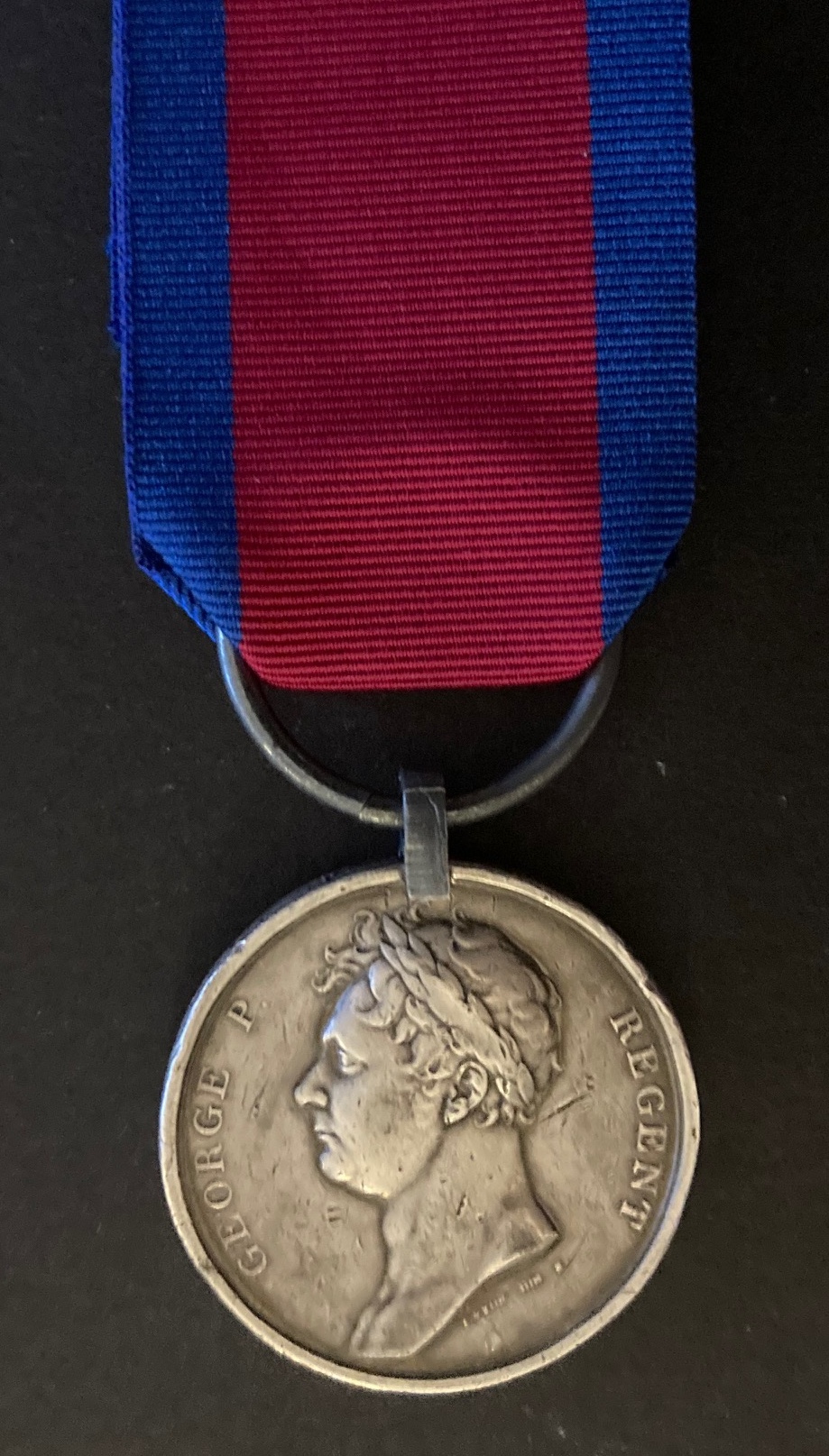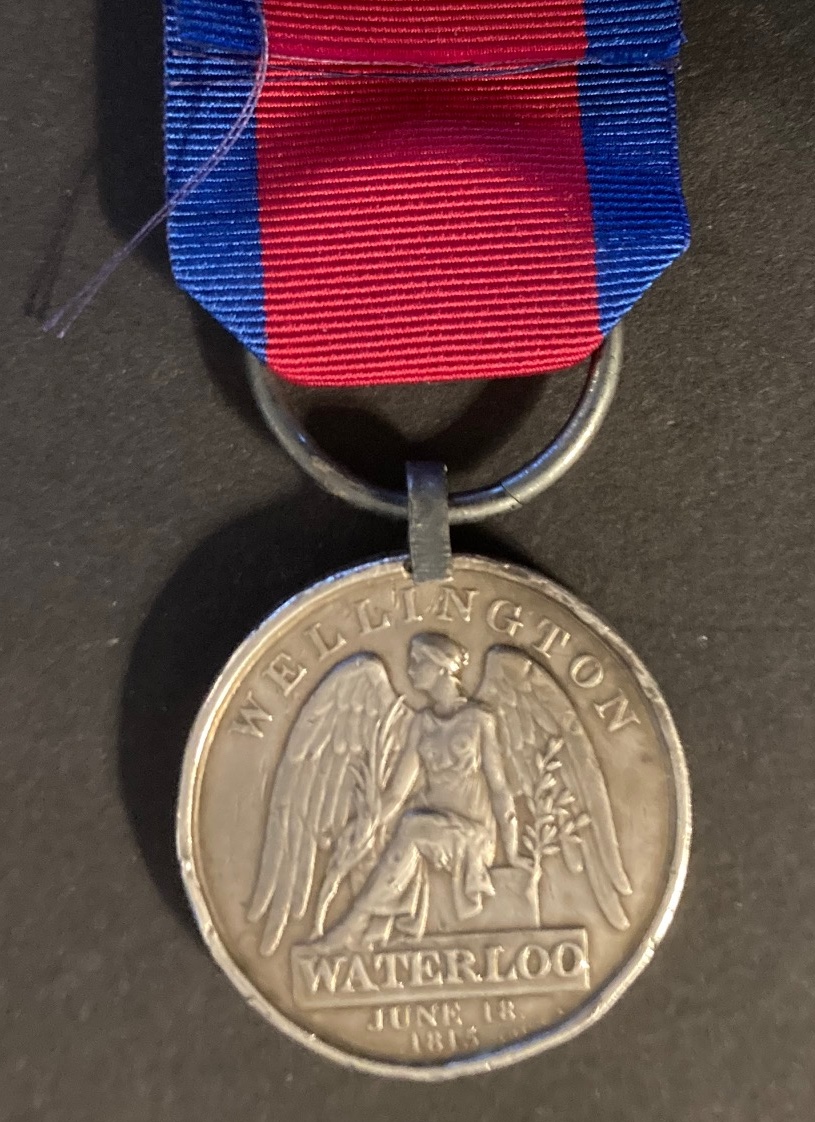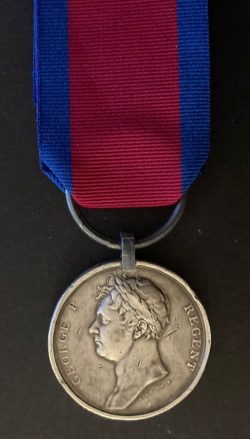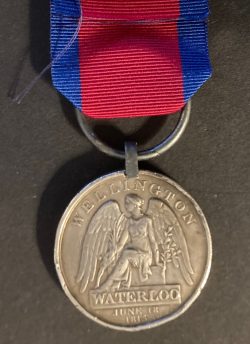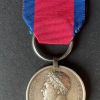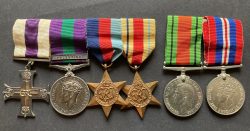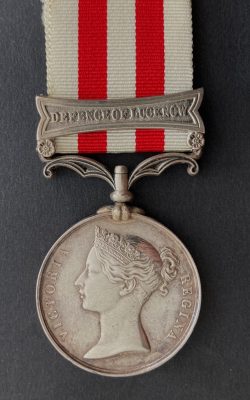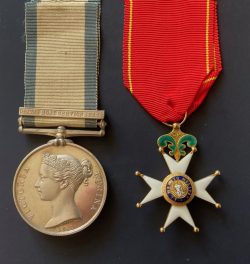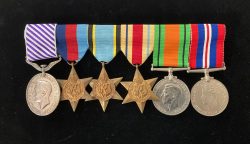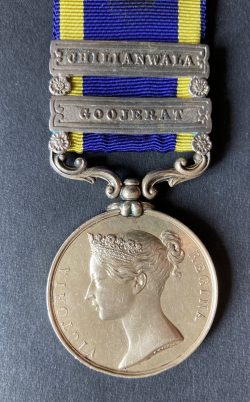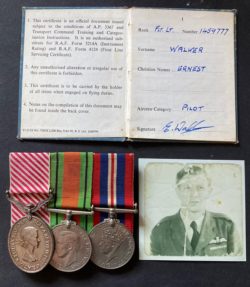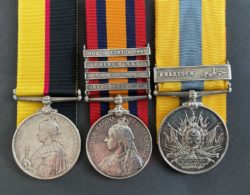Subtotal: £3,500.00
Waterloo to a Scot’s Greys casualty, severely wounded by a lance indicating that the recipient was present throughout the charge and subsequent action until finally fallen on by Jaquinot’s lancers
£5,500.00
Out of stock
Waterloo
James Gibson, 2nd or R.N. Brit. Reg. Drag
Severely wounded by lance at Waterloo
Copy Kilmainham discharge papers
Born Stewarton, Ayr 1792/3, enlisted. 1810, discharge. 1819 ’Totally unfit for further service. That his conduct has been vey good, was severely wounded on the 18th June, 1815.
Surgeons report ‘Wounded by a lance in the right arm on the 18th June, 1815.’
Additionally
‘Contracted a pulmonic complaint in the campaign of 1815 on the march to Waterloo by exposure to wet and moisture and since that time has been subject to the almost constant spitting of blood and difficulty in breathing and a tendency to pulmonic consumption.’
Died 1846 , Stewart, Ayr, buried St. Columbus churchyard and kirkyard, Stewarton.
Waterloo
As the rest of the British heavy cavalry advanced against the French infantry, just after 1:30 pm, Lieutenant-Colonel Hamilton witnessed Pack’s brigade beginning to crumble, and the 92nd Highlanders falling back in disorder.[On his initiative, Hamilton ordered his regiment forward at the walk. Because the ground was broken and uneven, thanks to the mud, crops, and the men of the 92nd, the Scots Greys remained at the walk until they had passed through the Gordons. The arrival of the Scots Greys helped to rally the Gordons, who turned to attack the French. Even without attacking at a full gallop, the weight of the Scots Greys charge proved to be irresistible for the French column pressing Pack’s Brigade.
As Captain Duthilt, who was present with de Marcognet’s 3rd Division, wrote of the Scots Greys charge:
‘Just as I was pushing one of our men back into the ranks I saw him fall at my feet from a sabre slash. I turned round instantly – to see English cavalry forcing their way into our midst and hacking us to pieces. Just as it is difficult, if not impossible, for the best cavalry to break into infantry who are formed into squares and who defend themselves with coolness and daring, so it is true that once the ranks have been penetrated, then resistance is useless and nothing remains for the cavalry to do but to slaughter at almost no risk to themselves. This is what happened, in vain our poor fellows stood up and stretched out their arms; they could not reach far enough to bayonet these cavalrymen mounted on powerful horses, and the few shots fired in chaotic melee were just as fatal to our own men as to the English. And so we found ourselves defenceless against a relentless enemy who, in the intoxication of battle, sabred even our drummers and fifers without mercy.’
A lieutenant of the 92nd Highlanders who was present would later write, “the Scots Greys actually walked over this column”.
Having defeated the French column and captured one of its battle standards, the Scots Greys were now disorganised. Neither Ponsonby nor Hamilton were able to effectively bring their troopers back under control. Rather than being able to reorganise, the Scots Greys continued their advance gaining speed, eventually galloping, and now aimed at Durutte’s division of infantry. Unlike the disordered column that had been engaged in attacking Pack’s brigade, some of Durutte’s men had time to form square to receive the cavalry charge. The volley of musket fire scythed through the Scots Greys’ ragged line as they swept over and round the French infantry, unable to break them. Colonel Hamilton was last seen during the charge, leading a party of Scots Greys, towards the French artillery. However, in turning to receive the Scots Greys’ charge, Durutte’s infantry exposed themselves to the 1st Royal Dragoons. The Royal Dragoons slashed through them, capturing or routing much of the column.
Having taken casualties, and still trying to reorder themselves, the Scots Greys and the rest of the Union Brigade found themselves before the main French lines. Their horses were blown, and they were still in disorder without any idea of what their next collective objective was. Some attacked nearby gun batteries of the Grande Battery, dispersing or sabring the gunners. Disorganized and milling about the bottom of the valley between Hougoumont and La Belle Alliance, the Scots Greys and the rest of the British heavy cavalry were taken by surprise by the counter-charge of Milhaud’s cuirassiers, joined by lancers from Baron Jaquinot’s 1st Cavalry Division.
As Ponsonby tried to rally his men against the French cuirassers, he was attacked by Jaquinot’s lancers and captured. A nearby party of Scots Greys saw the capture and attempted to rescue their brigade commander. However, the French soldier who had captured Ponsonby executed him and then used his lance to kill three of the Scots Greys who had attempted the rescue. By the time Ponsonby died, the momentum had entirely returned in favour of the French. Milhaud’s and Jaquinot’s cavalrymen drove the Union Brigade from the valley. The French artillery added to the Scots Greys’ misery.
The remnants of the Scots Greys retreated to the British lines, harried by French cavalry. They eventually reformed on the left, supporting the rest of the line as best they could with carbine fire. In all, the Scots Greys suffered 104 dead and 97 wounded and lost 228 of the 416 horses. When they were finally reformed, the Scots Greys could only field two weakened squadrons, rather than the three complete ones with which they had begun the day.
A few small edge bumps.
A scarce Grey’s casualty
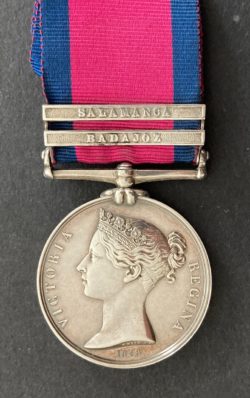 Military General service, clasps. Badajoz, Salamanca, 4th Foot. Wounded in the leg at the storming of Badajoz and again the thigh at New Orleans,
Military General service, clasps. Badajoz, Salamanca, 4th Foot. Wounded in the leg at the storming of Badajoz and again the thigh at New Orleans, 